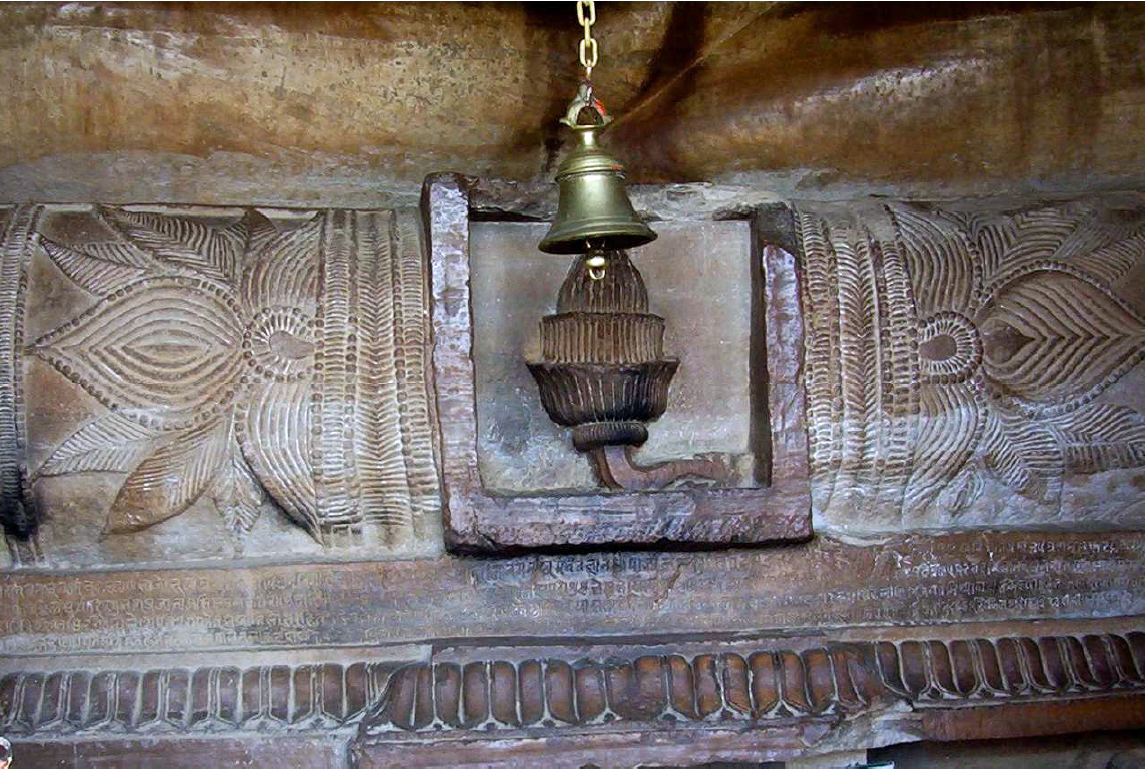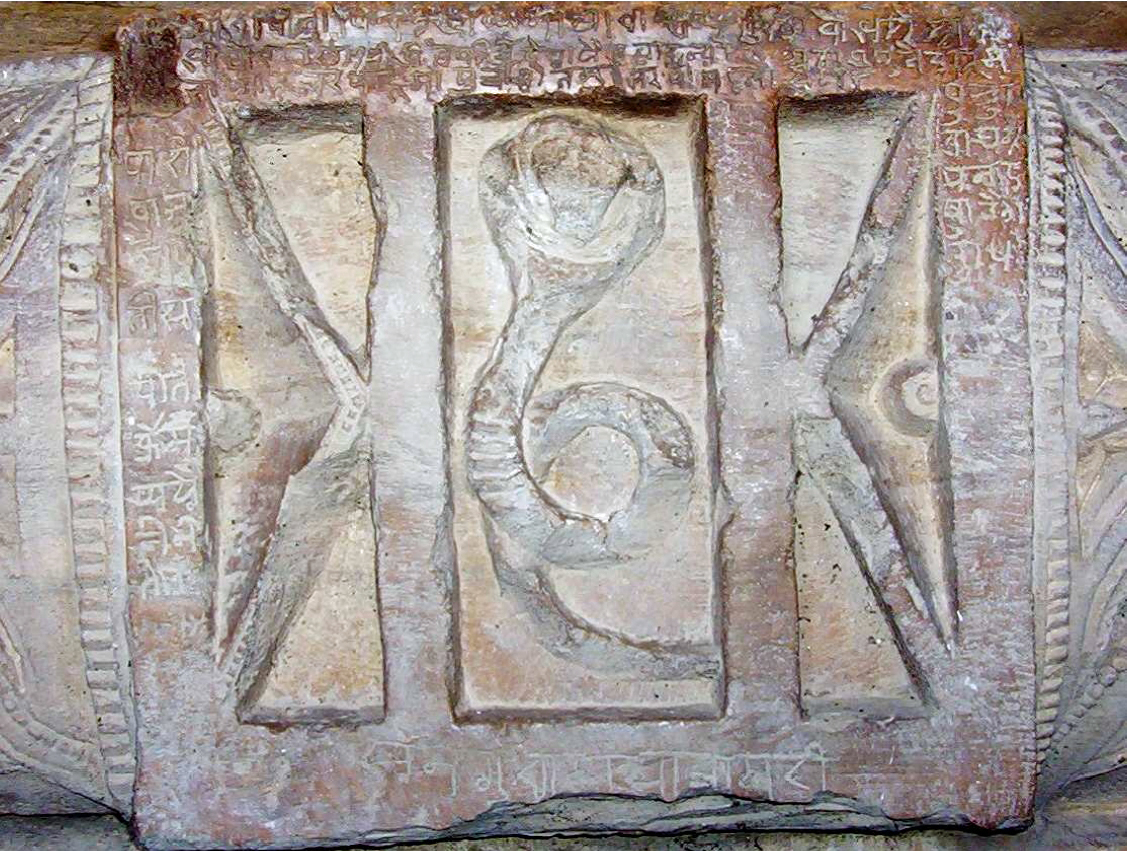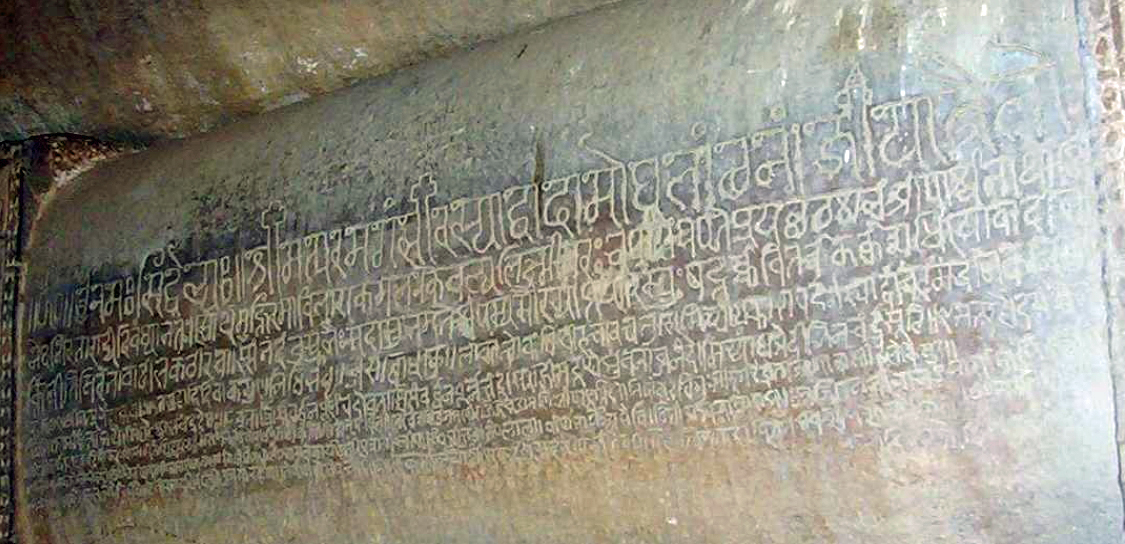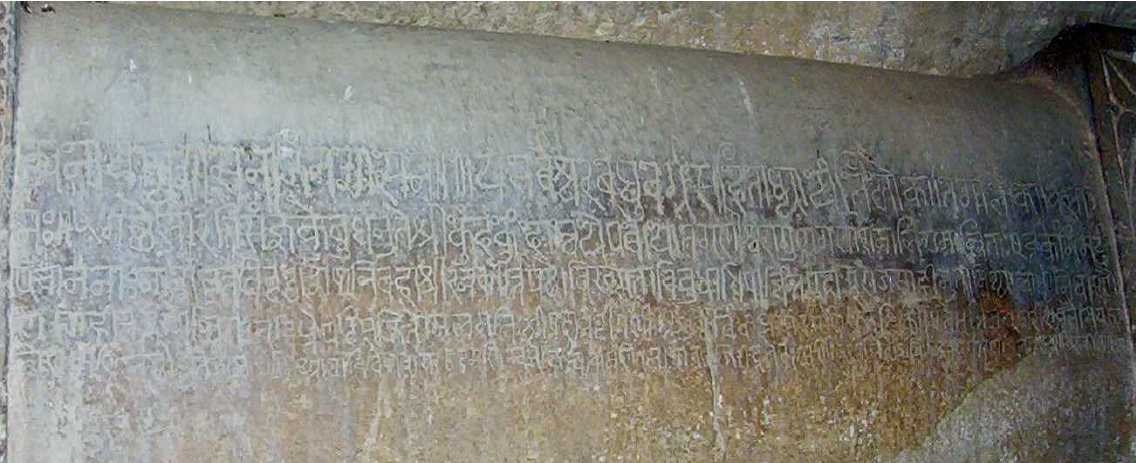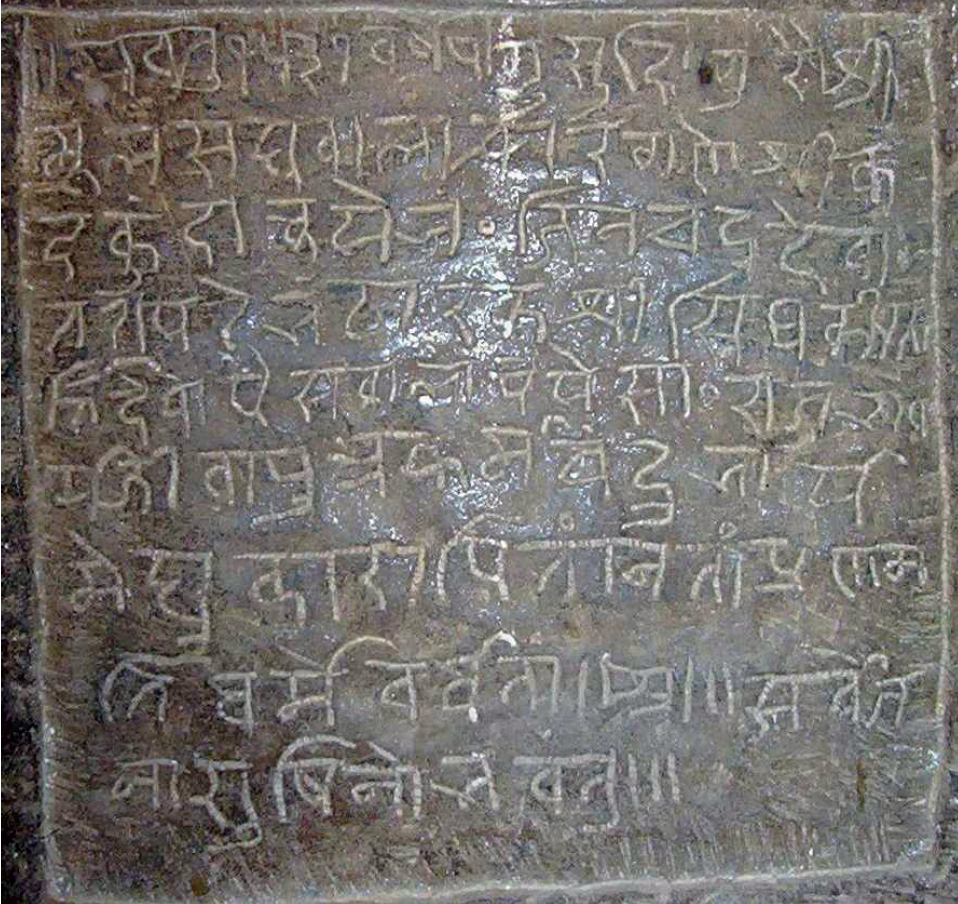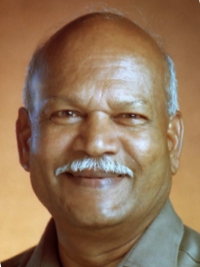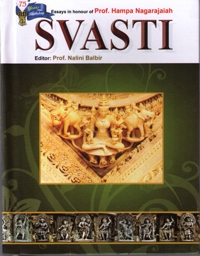8
Some Rock-cut Jain Temples of Gwalior Fort and their Inscriptions
Gwalior is a district and divisional headquarters in the State of Madhya Pradesh in India. Historical fort of Gwalior is famous for its impregnable condition, water management, art, culture, trade and military activities. The references in the early medieval inscriptions for Gwalior as Gopāchala, Giri-durga, Gopāchala-durga, Gopāchala-durgasthāna, Gopa-girīndra-durga, Gopāchala-parvatāgra, Govardhana and Girivara emphasized repeatedly the nature of Gwalior’s hill feature and fort. It has witnessed the rise and fall of many kings and their dynasties. Moreover the strategic position of the fort, its religious status as a tīrtha is also noteworthy. Remains of numerous temples and sculptures as well as inscriptional and literary references signify the importance of fort as a tīrtha. Its character as a Jain centre of pilgrimage received a fillip with the construction of a Jain temple by Āma who finds mention in the Prabandha Kośa.[1] Some early Jain sculptures of the fort are reported by Michael W. Meister and others.[2] There are several Jain caves and sculptures in the fort that are grouped in the Urvahi, South-Western, North-Western, North-Eastern, and South-Eastern. They are built or excavated generally during the Tomara rules, by and large from the time of Vikramadeva to the times of Kīrtisiṃha (A.D. 1403-1480). It is not possible to discuss the details of all these groups here, so the concentration is only on the North-Western group of Jain cave temples and inscriptions.North-Western group of Jain art occurs on the western cliff of the fort near the Ḍhonḍhā gate (26º14’00” north; 78º10’04” east). Due to the nearby famous Śiva temple these Jain caves are also known as Koṭeśvara Mahādeva group. The group consists of five rock-cut cave temples. Of them, due to much higher position two caves are not easily approachable. They do not retain any sculpture and it seems possible that on any circumstantial reason they were not completed and left unfinished.
The size of the sanctum of cave temple 1 (from the Koṭeśvara Mahādeva side) is 9’10” x 16’8” x 18’5” and its narrow entrance is of 4’ x 2’5” size. The cave is devoted to tirthaṅkara Pārśvanātha seated in padmāsana. The pedestal of the image bears an inscription dated in Vikrama Saṃvat 1527. There are also twelve tīrthaṅkara images in kāyotsarga that are carved in the side walls of the cave temple. They are of ṣabhanātha, Candraprabha, Padmaprabha, Vāsupūjya, Śāntinātha, Mahāvīra and others. Cave temples 2 and 3 are engraved in a similar pattern, having only garbhagṛha (sanctum), elevated in double stories. The approach ladder for the second story is carved in the rock. In these cave temples an attempt has been made to show the Nāgar style Śikhara by carving it in the upper rock. The size of the sanctum of rock-cut cave no. 2 is 17’2” x 14’11” x 28’ with an entrance of 8’3” x 3’10” and of cave no. 3 is 13’7” x 15’9” x 29’6” with the entrance of 7’ x 4’ size. The sanctum of cave no. 2 consists of the image of Padmaprabha seated in padmāsana and cave no. 3 bears an image of Pārśvanātha in padmāsana. Apart from the main image, there are four other images of ṣabhanātha, Candraprabha, Neminātha and Pārśvanātha in cave 2. Likewise, cave 3 has two Jina-paṭṭas and more than fifteen Jain images. Of them, Candraprabha, Neminātha, Pārśvanātha could be easily identified. On the pedestal of the Pārśvanātha image in cave 2 there is an inscription of Vikrama Saṃvat 1527. On the other hand cave no. 3 comprises eight inscriptions. Of them four are dated in Vikrama Saṃvat 1531. Two of them are engraved on the pedestal of the main Padmaprabha image; one is on the left wall and the other on the front wall of the second floor. The ceiling is decorated with full bloomed lotus. On the basis of the inscription, it could be assumed that the caves no. 1 and 2 were completed in Vikrama Saṃvat 1527 (A.D. 1470) and no. 3 in Vikrama Saṃvat 1531 (A.D. 1474). These caves were engraved with the assertion of Bhaṭṭāraka Siṃhakīrti in the reign of Tomara ruler Kīrtisiṃha.
A. Padmaprabha Image Pedestal Inscription: VS 1527
The inscription is engraved on the pedestal of a Jina image of Padmaprabha seated in padmāsana in the cave no. 2. It has 7 lines. All the inscriptions of this group are written in Sanskrit language and Nāgarī characters. Some earlier scholars have reported about this inscription.[3]The inscription records the ruling king Śrī Kīrtisiṃha and his father Ḍuṃgarendra and has the mention that with the assertion of Śrī Siṃhakīrti the image of Padmaprabha was installed. The inscription also talks about Khena, son of Paṇḍita Thiru, Pāṇī’s son Paharāja and Guṇī’s sons Padmasiṃha and Narasiṃha. It further mentions the wife of Padmasiṃha namely Padamī and their four sons and their wives.
TEXT
(Plate 8.1)
- // Siddham // siddhi // oṃ namaḥ siddhebhyaḥ // trailokye gājiveśāḥ sakala sukhutāḥ sarvvebhavyavjeha sāhitho doṣāribhūtāḥ paramapada-mitāḥ śāṃtabhāvaikalītāḥ hītāmohenadītā Nayacaṃdanacanāḥ paṃcakalyāṇa bhāno bhūyāsca dīvi sūbhrai vibhravaṇa-gahitās=tīrthadevarpabhādyaḥ //1 jinama-vadya-manaṃ-va-jïānasvā-prājvalasvaraḥ japadama ubhavatāy=anvaya ……………….. parama-sukhanita-mana-dharmma-japa-praṇamy=asphuṭa-padamih=āsvinikhāmi //2// saṃ 1527 varṣe // vvaradvadeṃ- hitaukāṃkaukitehāyane śubhe / hemalaṃnitimāghīyosite pattedhi paṃcami / bhārgaveha satakṣatre pratiṣṭhābhūrjji-
- neśituḥ // 3 // śuddhe-śrī-Mūlasaṃghe-Vimalagaṇa-Valātkāra-nāmni prasiddho-gaṇo-gacche gariṣṭhe guṇagṇaatilape Kuṃkuṃd=ānvayesmit / jñātā-śrīpati-saptapramukhapativadhyaḥ padamaṅgeka-bhūryādiśyur= bhavya prajānāma silavalaya śaṃtyeṃṣṭhitā śrītya-vidhi // 4 // śrī- Ratnakīrtti-rata-vadyamūrtte padyodayādrauśu śubhe-śubhasmi śrī-Prabhasiddha vidyojan=etābhidaṃsūḥ padyavitīrasva varāḥ prakṣeṃdraḥ // 5 paṭṭevadīye munit-Padyanaṃdī maṃdā ……… saṃghamadātha ……. niyitaḥ dharmaśā tasmālimāloryita ……….. pāradhasva śrīdyītat-paṭṭehi jiteṃdriyaḥ paramata kṣoṇītahīmāseśaḥ / maṃ guṇe …….
- digvāsāḥ paramātma-ciṃtanapaṭuḥ preṃkhatkilā-pūritāś=citve dharma-matiṃ-tatvotuma-gatāṃ śrī-Madhuneṃḍa guruḥ // 7 mithyāvādatamaḥ tasūdavanna taptādaryaptisāyuta paṣṭhāvādāmdataḍārai dhiryaṇāta-dhirīṇotpanno saṃpannayatā varateśūptasātilobharahitaḥ padveśu-vaṃdoḥ śubhrājātaḥ śrī-Jinacaṃdradeva muniṇedeyāt-satyama-tanaṃ // 8 // tatpaṭṭena ta śāstrajño jagadānaṃdakārakaḥ / Siṃhakīrttirvijayate mithyāvāhītatkeśarī // 9 tatkesāitadhītayaptana ……….. śrīḥbhāragaṇasa-khyāta munijatavratmani mūlasaṃgha vilasakṣīrādhirga-bhovalat= haṃvola pravimallagīr=vijayate śrī-Siṃhakīrtti guruḥ // 10
- śrī-Gopācalamabhige anaṇutviḍbhiḥ prabhākaraḥ / paribhramabhyaṃ varesmitkurvvannī rājanāmiva // 11 tatrāsī Ḍuṃgareṃdraḥ sakala-ripūkule-vrātāta ghātapātordhuro śreṇigarāṇati chā vimala śubho yātoda prabha-dānaḥ / dānai munipattaihi namamati samatāyena lokaṃ nṛpāṇāṃk= eṣām=eśaṃ-dravitaṃtha bhavadhiti pūṇathvaṇaṃta tajaṇātāṃ// 12 kīrtti śrīrnanu Kīrttisiṃha nṛpateḥ se vaṃdhanurvvabhava / pāmālokāvita varayaṃ vinitarāṃbha kroddhidāḥ sarvvadā/ karpūraiḥ kimapūri kiṃtriruvaṇa śrīpa ………… śrītaisatālātrayā paṃḍita Thiru tatputraḥ Khenā bhāryā Pāṇītṣṭhāḥ putraḥ Paharājaḥ / bhāryā Guṇī / tayo putrau Padamasiṃha Narasiṃho / Padamasī bhāryā Padamī tayoḥ putrāścatvāraḥ
- ……………………. bhāryā mahā putrau Jinadāsasa Jālhīsau Jālhī bhāryā Nāo / Viharāja bhā. Dhāgūtiyā putrau Dhosū / Nemidāsā tāsū bhārya Tālhībha / oṃ // saṃghavījā-
- mapadūjadi-miśratu …… pratiṣṭhāpitaḥ // // śrī Kalaramamanīmadyo dvādāmāghanāṃtu …………. vara-eṣu-bhṛtibhiś-caturbhiḥ sadyari bhuveḥ śrī Padmaprabhaḥ pratiṣṭhāpitaḥ // // śrī Chatparamamabhīrasyā-dvādāmoghalāṃchane / jīyā trailokyanāthasya śāmaḥ jinaśā-
- sanaṃ
B. Pārśvanātha Image Pedestal Inscription: VS 1527
The inscription is engraved on the pedestal of Pārśvanātha image in cave no. 1. It bears 18 lines. It is dated in 1527 of Vikrama year that corresponds to A.D. 1470. The inscription mentions Bhaṭṭāraka Siṃhakīrtti, Āchārya Sāmādharī, and some members of the Jaisvāla family. After engraving the upper three lines the engraver continued to carve the letters in the right margin and then moved to the left margin while the last line is written separately in the lower margin. Due to the carelessness in engraving and broken portion of the upper left margin few letters are not readable now.
TEXT
(Plate 8.2)
- Sidhi saṃvat 15[2]7 -----------------------------śrāvā---------vāśa bhaṭṭā[ra]ka-
- syaṃ dhoraparagat śrī-Siṃghkīrttideva / Jaisavālānvaye aṭhāsu-putrai Prītama-
- stā Ābhū Jara Pāhamo putro Sotamā Jaraṭhā Madano Sātama
- putrā
- Vāghagū
- Panāda
- Shāuge
- Rāshī
- Pāro
- Śujau-
- yya pra-
- tīsṭhā-
- pītaṃ
- karmā-
- ppa(ksha)yai
- jine-
- tām
- sanagucārya Sāmādharī
C. Pārśvanātha Image Pedestal Inscription: VS 1531
The inscription is engraved in 9 lines on the pedestal of the image of Pārśvanātha in cave no. 3. The inscription is reported by earlier scholars.[4] It bears the date in Vikrama saṃvat 1531 that corresponds to A.D. 1474. The purpose of the inscription is to record the installation of Pārśvanātha image by Saṃghādhipati Chāṃpā at the assertion of Śrī Siṃhakīrti in the reign of Tomara ruler Kīrtisiṃha. It also mentions several members of the Jaisvāla family. Interestingly, here we find mention of three wives of Saṃghādhipati Lālā, namely Rāmatā, Vidho and Dharu.
TEXT
(Plate 8.3 A-B)
- // Siddham // oṃ namaḥ siddhebhyaḥ // śremate-paramagaṃbhīrasyā dvādāmogha-lāṃchanaṃ / jīyāttrailokyanāthasya śāsana jinaśāsanaṃ // 1 // yaṃ sarveśvara-vaṃdhuvarggasahitādhyāyaṃ trilokātigālokā vibhāga-
- nedagiratārādyaṃ divaṃdhyānataḥ / saurya-muktiramāvilārā-kamalaḥ kaivalya / Lakṣmīdharaḥ ca pāyathapateprayaccha uṣalaṃ śrī-Pārśvanāthojinaḥ // gacchebhārati saṃjïake vudhanute śrī-Kuṃdakuṃdānvaye patha / yā bhagaṇīśvarā-guṇagaṇā-rāmābhirāmām= ānvitāḥ ṣadvakremi / [3] mayuṃ-
- sti nītiniratā-vādīla-kaṃṭhīravā / ssanaṃdaṃ-vusulaiḥ sadāsubhamatesyaṃ-pasya 4 saurabhyāptayārisyuḥ padūr=kvacitavvakekvaśedhiyo vādame paṃcāmanāḥ nānāvṛtta vibhṛdva śiṣyanivadvā śrī-Ratnakīrttipade / vikhyātā vivudhādhipaucchita padāḥ pūrojasāhīnu-vāmithyātvāṃdhya-nivāraṇai
- kavvipuṇā śrīmatprabhaṃdvāhvayāḥ // 5 tatpaṭṭādri divākaguṇanidhir= bhavyāvja savvodhaṣo lokāṃloka vicārucāra caturo mithyāṃdhakārā-padaḥ / syādvāṃ varamadr=anaika-nipuṇadyā hīmayugvānvitaḥ ca-dviprai-padim=ajitaumalamuni śrī-Padyanaṃdī gaṇī // 7 śreṣṭhair-vidhātrira-padagaṇi-pujai śrī-kīrṣita-mūrttimayaṃ śarīravalotha yasyā-
- khila-karmaharttā-bhavyau-siṃdhoḥ Śubhacaṃdradevaḥ // 8 vratārddho saṃvarddhana-pūrṇapado-vratāśri-saṃvarddhana Pūrnnacaṃdra / syāhī mayukhai bhuvanāvjanaṃdo mithyāṃ dhamedī Jinacaṃdrasūri // 9 tatpaṭṭodaya śailaśekharamaṇinatvo yete jomaṇirmmithyāyādi vitvāśaṇahada maṇisvame dhinvatāmaṇi dhanīsāvāda girīdramedat= maṇiḥtkasīsetye dhanibhedattayā sahaṇātsala-maṇiḥ śrī-Siṃhakīrtti gaṇī
- śrī-bhūpālati bhaṭakoṭinikaraḥ kimmā retāṃdhri-dvayaḥ śrī-Gopācalar-bhaḍatona-dhanusaḥ śrī-Kīrttisiṃho tapaḥ / ttena-Tomara vaṃśa-caṃdrana maṇīrājadra cūḍāmaṇiḥ vīpāryama ratoniśivara vibhuḥ śrī- Ḍūṃgareṃdrotmajāḥ // 11 astīhalokesura //
- śrī-Jaisavālānvayo Sīrapāṃ Sadyau bhāryo Nalhī putrāḥ saṃ. Āsala / Ganā / Sāraṃga / teṣāṃ madhye saṃ. Āsala bhāryā Manī putrāḥ saṃ. Vīṇa (Vaṇi) saṃ. Bhāvaḍa saṃ. Lālā / Vaṇi bhāryoḥ Abhaiti / ditīya bhārayā Aṇamā putra jiṇana Dārābhadra bhāryā Māṇihade //
- saṃ. Lālā bhāryau Rābhatāde dvi Vidho / tṛtīya bhāryā Dharupatnī / putrasta Rahasya // teṣāṃ madhye saṃ. Chāṃpā / tā karma-kṣayārthaṃ su kuṭuṃle saha śrī-Pārśva-daivasu pratiṣṭhā Tilapādāpitaḥ / saṃvat 1531 varshe Tāla // 70 śrī jiṇatāṃ
- [praṇami]tsa nityo //
D. Inscription of VS 1531
There is an 8 lines inscription engraved on left wall of the upper story of cave no. 3. Due to the damage and carelessness in engraving, it is not easy to read some of the letters. The date of the inscription is mentioned in line 1 as Saṃvat 1531 varshe Kārtika sudi 5 and Friday. The inscription records Siṃhakīrtti who was the disciple of Bhaṭṭāraka Jinachaṃdra and mentions the family member of Sādhu Subhaga.
TEXT
(Plate 8.4)
- // Saṃvat 1531 vaṣe kā ……. sudi 5 Su-
- kro bhaṭaraya śrī-Jinacaṃdra / tatpaṭṭom
- śrī-Siṃhakīrtti sādhu Subhagatsadyā Bhā-
- ramā putrāya Damalo putra sā. Dhāravī
- Halī putra Hījāmusī putrāya
- Kukāma Vinayasu Tāraṇa Mahū
- putrāya Ajamu Jasyateṇa
- putra Varijaisyasita …….
E. Inscription of VS 1531
There is a 9 lines inscription engraved on the upper story left wall of cave no. 3. The date of the inscription is mentioned in line 1 as Saṃvat 1531 varṣe Pauṣa sudi 1 and Thursday. The inscription records the installation of image by Meghu, wife of Karmacaṃdra on the assertion of Siṃhakīrtti. Karmacaṃdra was a member of Jaisvāla family whose father was Sādhu Rāja and mother named Jīvā. It also mentions that Bhaṭṭāraka Siṃhakīrtti was the disciple of Jain Āchārya Bhaṭṭāraka Jinacaṃdra who belonged to Mūlasaṃgha and Balātkāragaṇa.
TEXT
(Plate 8.5)
- Saṃvat 1531 varṣe Posu sudi 1 Gurau śrī-
- Mūlasaṃgha Vālātkāra-gaṇe śrī-Kuṃ-
- dakuṃd=ānvaye bha. Jinacaṃdra-devā
- tata-paṭṭe bhaṭhāraka śrī-Siṃhakī-
- rttidevo pai(Jai)savāla-vaṃse sā. Raja bhā-
- rya Jīvā putra Karmacaṃdu bhārya
- Meghu kārāpitaṃ nitāṃ praṇama-
- ti dharme-vardhatāṃ // śrī // sarveja-
- nā suṣino bhavaṃtu //
F. Inscription of VS 1531
The inscription is engraved on the front wall of the second story of cave no. 3. It is dated in Vikrama saṃvat 1531 Phāguṇa sudi 5 Friday which corresponds to 10 February 1474 A.D. It records that Bhaṭṭāraka Siṃhakīrtti was the disciple of Bhaṭṭāraka Jinacaṃdra who belonged to Mūla-saṃgha, Balātkāra-gaṇa and Sarasvatī-gaccha. It also mentions the Sādhu Gāṃgū and his family members of Jaisavāla and Ikshvāku lineage. Plausibly, Kuṭaṃba installed an image in this cave with the help of Sādhu Dhamū.
TEXT
(Plate 8.6)
- // siddham // saṃvat 1531 varṣe Phāguṇa sudi 5 śukre // śrī-Mūlasaṃghe //
- Valātkāra-gaṇo Sarasvatī-gacche bhaṭṭāraka śrī-Jiṇacaṃdra //
- tatpaṭṭe śrī-Siṃhakīrtti-devāḥ // pratiṣṭhitaṃ // Jaisavālānva-
- ye / Ikṣavāku / vaṃśe // sā. Gāṃgū / bhāryā Vīlhā putra sā.
- Mahirāja bhāryā Susīlā / putrāḥ / Dhamū / Caṃdasiri //
- dvi. sā. Gaṇū bhāryā Jasovai / puṃ. Rāimalu / tṛtī-
- ya bhrātṛ sā. Diugaṇa bhāryā Abhayasiri //
- teṣāṃ madhyesu-Kuṭavai saha sā. Dhamū saha //
- kārāpitaṃ // sā. Devagaṇe sahakāyapitaṃ //
G. Pārśvanātha Image Pedestal Inscription of VS 1531
The inscription under discussion is engraved below the above mentioned inscription C in cave no. 3. It is interesting to note here that the letters after jīya and before the numeral 1 is written in blank ink and the engraver left them to carve. It is dated in Vikrama Saṃvat 1531 Phālguna sudi 5 Śukra which corresponds to A.D. 1474.
TEXT
- // Siddham // oṃ namaḥ siddhayebhyaḥ // śrīmat-parama-gaṃbhīrasy= ādvād=āmogha-lāṃchanāṃ jīya ………. ghasya śāsanaṃ jina-śāsanaṃ // 1 // saṃvat 1531 varṣe Phālguna sudi 5 Sukre //
H. Other Inscriptions
There are three more inscriptions in the cave no. 3. Of these, one is carved on the wall of upper story. It has 5 lines. Most of the letters of the beginning of each line are now obliterated. Due to that the purport of the inscription is not clear. However, the name of the wife Dharāśrī, Ajaiśrī, Karamasī could be read out in the preserved portion. It ends with the proclamation that the image was adored by the people.
Another inscription of the cave records the name of Kāmadhari who was the son of Sutradhāra Senā. There is a possibility that this person was responsible for some or most of the constructional work of this group of Jain art. The third inscription consists only of the name of Paṇḍita Śrī Chaṃda.
Meister, Michael W. 1975. “Jain Temples in Central India”, in Aspects of Jain Art and Architecture, eds. U. P. Shah and M. A. Dhaky, Ahmedabad, pp. 223-242; Cunninham, A. 1972 (reprint). Archaeological Survey of India Report, Vol. II, Varanasi.
Annual Administrative Report, Archaeological Department, Gwalior State: (GAR), (1984 / 1927-28) no. 40; Dwivedi, Harihar Niwas VS 2004. Gwalior Rājya ke Abhilekha, Banaras: (GRA), no. 307; Annual Report of Indian Epigraphy: (ARE), 1961-62, no. 1526; Willis, Michael D. 1996. Inscriptions of Gopakshetra, London: (IG), p. 36.
 Dr. Arvind Kumar Singh
Dr. Arvind Kumar Singh
